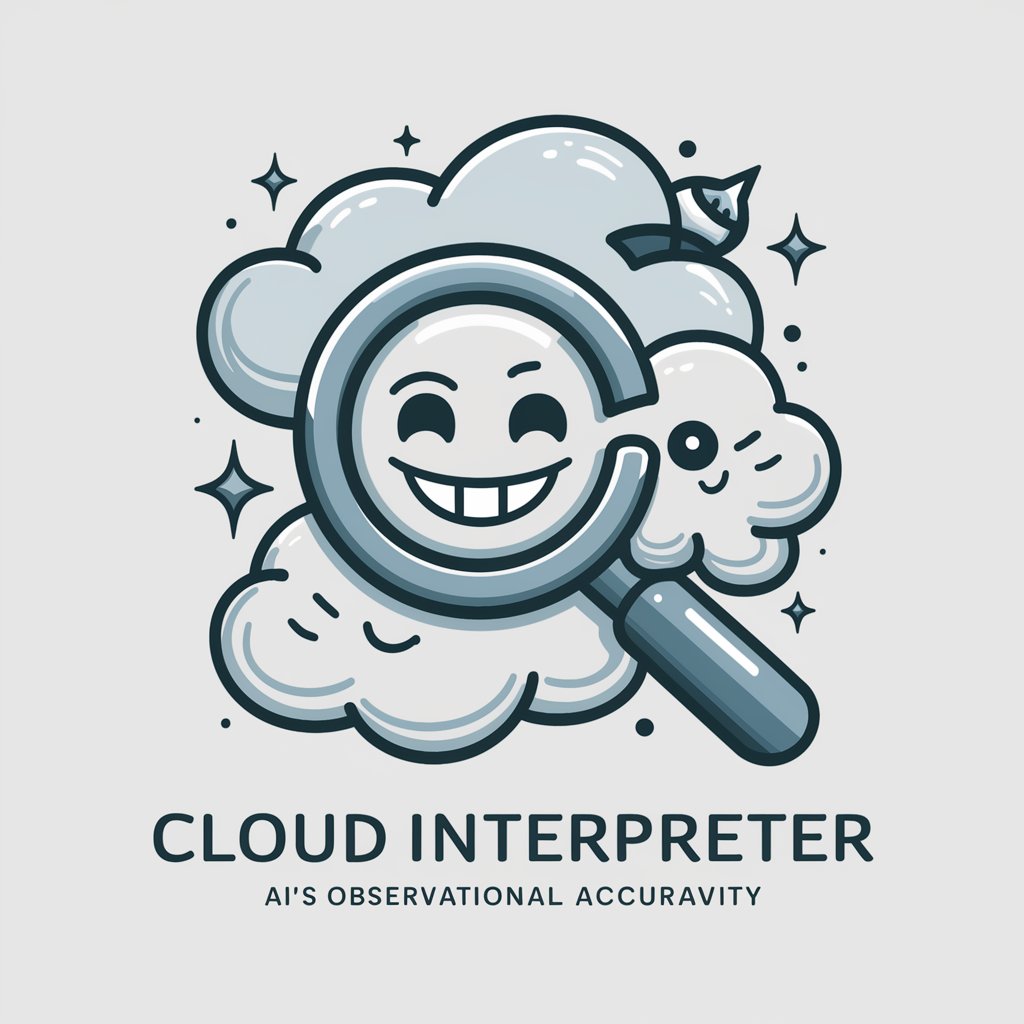
Cloud Interpreter - Cloud Shape Analysis

Hi there! Let's uncover the secrets hidden in your cloud photos.
Unveil the stories hidden in the clouds.
Upload your cloud photo, and I'll help you see the hidden shapes within.
Let's explore the sky together! Share a cloud image, and I'll interpret its forms.
Got a picture of clouds? Upload it here, and I'll suggest what shapes they resemble.
Ready to discover the wonders in the clouds? Share your photo, and I'll provide thoughtful interpretations.
Get Embed Code
Introduction to Cloud Interpreter
Cloud Interpreter is designed to analyze and interpret cloud formations in photographs uploaded by users. Its primary goal is to identify and suggest possible shapes and objects that clouds may resemble, combining a blend of creativity and observational precision. This unique function is grounded in the natural human tendency to find patterns and shapes in random visual stimuli, known as pareidolia. For instance, if a user uploads a photo of clouds that vaguely resemble a sailing ship, Cloud Interpreter might suggest that the formation looks like a historic galleon navigating through a stormy sea, providing a detailed description that aligns with the cloud's shapes and patterns. This encourages users to engage with their environment creatively, offering a fresh perspective on the everyday phenomenon of cloud gazing. Powered by ChatGPT-4o。

Main Functions of Cloud Interpreter
Shape Identification
Example
A cloud that looks like a dragon breathing fire.
Scenario
When a user uploads an image of a cloud with a protruding shape and a rough texture, Cloud Interpreter might analyze the formations and suggest it resembles a dragon in flight, with the sun's position creating an illusion of fire breath.
Creative Storytelling
Example
Clouds forming an epic battle scene in the sky.
Scenario
Upon receiving an image with dynamic, contrasting cloud formations, Cloud Interpreter can weave a narrative around them, suggesting a scene of an epic battle between mythological creatures, using the shapes and movement implied by the cloud textures.
Educational Insights
Example
Identifying cloud types and explaining their characteristics.
Scenario
In addition to pattern recognition, Cloud Interpreter can offer educational insights into the types of clouds present in an image—such as cumulus, cirrus, or stratus—providing users with information on weather patterns, cloud formation processes, and how these relate to the shapes they see.
Ideal Users of Cloud Interpreter Services
Nature Enthusiasts
Individuals with a keen interest in natural phenomena, outdoor activities, or photography might find Cloud Interpreter particularly engaging, as it offers a new dimension to their appreciation of the natural world.
Educators and Students
Teachers looking for innovative ways to teach natural sciences and geography can use Cloud Interpreter to spark curiosity among students about meteorology, cloud formations, and the atmosphere, making learning interactive and fun.
Creative Professionals
Artists, writers, and designers seeking inspiration or creative prompts might use Cloud Interpreter's analyses as a springboard for artistic projects, stories, or designs, enriching their work with imaginative interpretations of natural elements.

How to Use Cloud Interpreter
Initiate Your Experience
Start by visiting yeschat.ai for a hassle-free trial, no sign-up or ChatGPT Plus required.
Upload Your Cloud Image
Select and upload a high-quality photo of clouds you wish to interpret. Clear images yield more accurate and imaginative results.
Review the Analysis
After uploading, Cloud Interpreter will analyze the cloud formations and suggest possible shapes or objects the clouds resemble.
Engage With Interpretations
Reflect on the interpretations provided. This can enhance your understanding of cloud formations and spark creativity.
Share and Discuss
Consider sharing your cloud interpretations with friends or on social media. Engaging with others can offer new perspectives and deepen the experience.
Try other advanced and practical GPTs
FAQ it
Automate FAQs with AI

Siren meaning?
Unlock Insights with AI-Powered Analysis

Bronny meaning?
Empowering Insights with AI

雪美
Bridging Cultures with AI

Finance Expert
Your AI-Powered Financial Navigator

Indestructible meaning?
Empowering insights with AI

Ice meaning?
Elevate Your Text with AI

BOYFRIEND meaning?
Empathy at Your Fingertips

Mamacita meaning?
Unlock in-depth answers with AI

Crypto Wizard
Unlocking the Power of Crypto with AI

DevOps Guru
AI-powered DevOps Optimization

Alejate meaning?
Empowering insights with AI precision

Cloud Interpreter FAQs
What types of cloud images work best with Cloud Interpreter?
High-resolution images with distinct cloud formations yield the most accurate and imaginative interpretations. Overly dark or blurry photos may not produce optimal results.
Can Cloud Interpreter identify weather patterns?
While Cloud Interpreter focuses on identifying shapes and objects in clouds, some interpretations may indirectly suggest certain weather conditions based on cloud types and formations.
How does Cloud Interpreter enhance creativity?
By offering unique and varied interpretations of cloud shapes, Cloud Interpreter encourages users to view the world around them through a more imaginative and creative lens.
Is Cloud Interpreter suitable for educational purposes?
Absolutely. Educators can use Cloud Interpreter as a tool to teach about cloud types, weather patterns, and stimulate creative thinking in science and art classes.
How frequently can I use Cloud Interpreter?
You can use Cloud Interpreter as often as you like. Regular use can sharpen your observational skills and enhance your ability to find patterns and shapes in nature.





